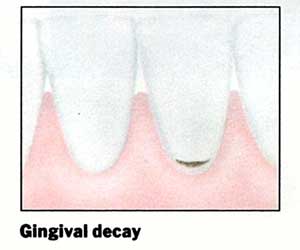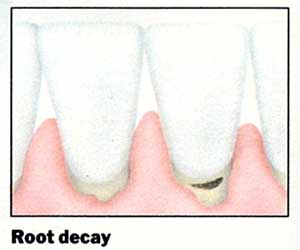Adult Tooth Decay
Information contained in this article is provided by the American Dental Association.
 Is tooth decay still an adult problem? It can be, but we are not helpless in the battle for healthy teeth in sdulthood. Nowhere is the improvement of Americans' dental health more evident than in the dramatic reduction of tooth decay.
Is tooth decay still an adult problem? It can be, but we are not helpless in the battle for healthy teeth in sdulthood. Nowhere is the improvement of Americans' dental health more evident than in the dramatic reduction of tooth decay.
Little more than a generation ago, dentistry largely focused on keeping up with an epidermic of decay. But today, half of children aged 5 to 17 have no decay. A cavity-free generation may someday be a reality, thanks to fluoride and other preventive measures.
Adult tooth decay is a whole other topic altogether. As adults, our focus needs to remain in place regarding dental hygiene.
 While tooth decay is declining, particularly in children, it still remains a problem for adults who did not have the advantage of fluoride and modern preventive dental care when they
were growing up. Adults often have secondary decay around old fillings and decay of tooth roots, which become exposed when the gums recede with age or due to periodontal disease.
While tooth decay is declining, particularly in children, it still remains a problem for adults who did not have the advantage of fluoride and modern preventive dental care when they
were growing up. Adults often have secondary decay around old fillings and decay of tooth roots, which become exposed when the gums recede with age or due to periodontal disease.
Certain bacteria in plaque produce acid that gradually breaks down the tooth enamel by dissolving essential minerals. Tooth roots are very susceptible to decay because they are covered with dentin, which is softer than the enamel covering the crown of the tooth. Tooth root decay is a major problem as we age, and especially for older adults. Over 60% of adults over age 65 have tooth root decay.
In other words, tooth decay is down, but not out yet.
The Adult Battle for Healthy Teeth
Brushing and flossing are essential. Clearly, an understanding of the causes of tooth decay and periodontal disease and the factors that influence their severity has led to an increasing emphasis on prevention. But are you convinced?
Like most people, you probably spend from 30 to 60 seconds brushing your teeth. That simply is not enough time to plaque effectively to maintain oral health. And it's likely that
you floss sporadically, if at all. Yet floss removes much of the plaque at the gumline and between the teeth that is most likely to lead to decay and periodontal disease.
For a few minutes a day spent on brushing and flossing at home, and another few hours in a dental office per year for checkups and cleanings, you can largely avoid dental prob-
lems. Dental health is relatively easy to achieve and maintain. Although many new products have been developed in recent years as dentistry has learned more about the specific causes of dental disease, experts agree that the toothbrush and floss remain the best weapons against plaque and tartar.
Your dentist or dental hygienist should be consulted for advice on proper brushing and flossing techniques tailored to your needs. The battle for healthy teeth and gums never ends.
How do periodontal problems develop?
Bacteria begins to form and multiply in the mouth shortly after birth. Almost immediately, our lifelong battle against plague begins. Plaque is composed mostly of bacteria, in combination with saliva, food and fluid secreted by the gums.
The heaviest concentrations of plaque tend to be at the point where the teeth meet the gums and between the teeth. If not removed daily, the bacteria in plaque multiply into colonies. In time, unremoved plaque hardens into tartar, a tough, gritty deposit that gives new plaque a rough surface to which it can cling.
Tartar can be removed only by a dentist or dental hygienist. The amount of plaque and tartar that form can vary greatly from person to person. Specific types of bacteria in plaque produce substances toxic to the gums and bone that hold the teeth in place. If plaque is allowed to grow, an inflammation of the gums called gingivitis occurs.
As periodontal disease progresses, gums begin to pull away and recede from the teeth. Pockets of bacteria form and deepen, gradually reaching and destroying the bone that anchors the teeth. In this advanced stage, known as periodontitis, teeth may be lost without prompt treatment by a dentist. While plaque is the chief cause of periodontal disease, other factors can influence your chances of developing the disease.
Conditions that interfere with the immune system--such as hormone imbalances from diabetes, thyroid malfunction and pregnancy - some medications, and hereditary factors all may increase the risk or severity of the disease. Tests are now being developed to identify factors that make some people more likely to develop periodontal disease.
Last Updated: September 20, 2022
About UDE
UDE is a free service designed to help place perspective patients with various oral care providers in close proximity. USA Dental Edge organizes oral care providers primarily by county (or borough/parish).




